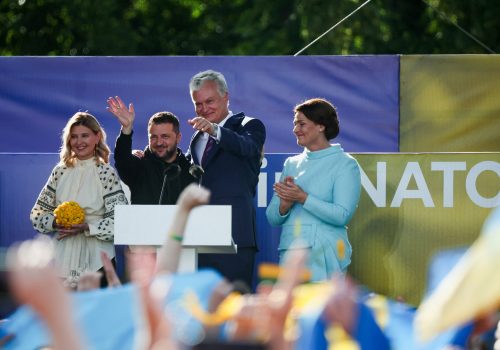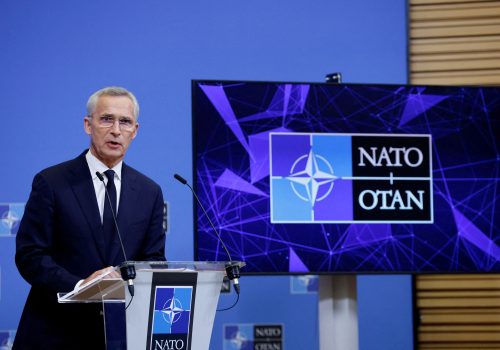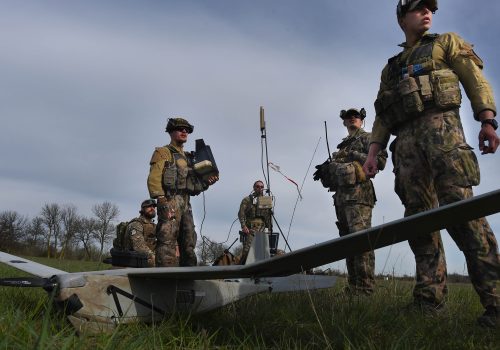How to keep NATO relevant into 2024 and beyond
As 2023 winds down, NATO is approaching the halfway point between the last leaders’ summit in Vilnius and the next one in Washington, where the seventy-fifth anniversary of the Alliance will be celebrated. It is, therefore, an opportune moment to take stock of what NATO has achieved and what still needs to be done.
NATO leaders did take important, if incremental, steps in Vilnius to build a stronger Alliance, but political will precedes everything else in the effort to rally more resources. While the allies recommitted to investing a minimum of 2 percent of gross domestic product (GDP) on defense and approved a new Defense Production Action Plan to accelerate joint procurement, there is still an urgent need for NATO to boost defense spending further.
The Vilnius summit’s communiqué contained ninety paragraphs of intentions, promises, and commitments, even though the most-discussed item at the summit—Ukraine’s NATO membership path—was not in the final document. Despite this setback, NATO’s path forward is clear: Allies must work to strengthen the Alliance, offer support and membership to those in dire need of security, and expand the organization’s partnerships to far-flung democracies worldwide.
The promised goal that all allies would spend at least 2 percent of GDP on defense, and that this would be a ‘floor’ of spending, remains elusive.
What has the Vilnius summit and the time since revealed about the Alliance, as the Washington summit in July 2024 approaches? The uncertainty caused by conditions at the front of Russia’s war on Ukraine, as well as by the Israel-Hamas war, is complemented by the volatility of domestic politics. And while the politics of the moment prevent NATO from making the most consequential decisions, the nexus of defense spending, investment, and advanced technologies, in addition to ensuring collaboration among allies, are low-hanging fruit that need to be picked as soon as possible. Looking back to Vilnius and forward to Washington, five observations emerge.
First, the risk of the narrative about the war in Ukraine being hijacked is real. The threat Russia poses to Europe and the smell of gunpowder are here, and they are especially evident in Central and Eastern European democracies that continue to vehemently support Ukraine and its people. But even there, as evidenced by the disputes in the runup to the Slovak and Polish elections, the war narrative can be dangerously misused. As 2024 approaches, and with it a perfect storm of elections worldwide, the challenge will arise in democracies to hold onto their support for Ukraine without allowing the narrative of the war to be hijacked by extreme populists who want to cut or end support to the country. With majorities in many countries still supportive of helping Ukraine, the question is, to paraphrase the poet William Butler Yates, “Can the center hold?” It is not just the future of Ukraine but of all of the democratic West that is at stake. NATO has an essential role to play in continuing to make these stakes clear.
Second, increasing defense spending has been a long-term objective that requires a constant political push. Russia and China have built up and continue to expand their militaries. Other authoritarian actors, such as Iran, are sowing instability, and the latest developments in Israel and Gaza demonstrate that vividly. Unfortunately, the extended war in Ukraine highlights the pitfalls and dangers of long-running Western underinvestment in defense. NATO needs to be ready to defend and deter with credible capabilities for as long as a conflict might take place. The promised goal that all allies would spend at least 2 percent of GDP on defense, and that this would be a “floor” of spending, remains elusive. Without the political will, efforts to increase spending are likely to fall flat, like they have done in the past.
Third, the complexity of investments in emerging technologies, traditional (legacy) weapons systems, and supply chains for components and critical minerals is overwhelming. Ukraine’s defense against Russia offers a stark case study of what the future of warfare will likely look like, showing how traditional firepower and advanced technologies must work in tandem. The effectiveness of artillery, tanks, and air defense is complemented by cutting-edge technology, drones, and artificial intelligence applications. What is needed is not an either‑or approach but an “all of the above” rationale, investing in strengthening both baskets of capabilities: advanced and emerging tech capabilities and the production of legacy hardware.
Fourth, allies must collaborate more effectively in delivering value from investments to keep NATO and its partners resilient and supplied. Better transatlantic and cross-border procurement, while politically treacherous, is key to rebuilding the Western arsenal. Some recent examples show a path forward: the Australia, United Kingdom, and United States agreement, or AUKUS, and the European Sky Shield Initiative, to name two. NATO’s innovation efforts are progressing with the launch of the Innovation Fund and the Defense Innovation Accelerator for the North Atlantic (DIANA). Yet, bolder moves in conducting joint procurements are needed to attract more private capital to the ecosystem and to bolster interoperability within the Alliance. The political will to push through these initiatives will serve as the ultimate test of the West’s ability to come together when urgently necessary.
Fifth, NATO summits hold immense convening power at the highest political level, but the Vilnius summit fell short in gathering relevant defense industry participants. The Washington summit should be a venue for industry and high-level policymakers to come together and make bold decisions on the way forward. It should serve as a bridge between industry and government experts and top political leadership, signaling a common commitment to work together, as well as be a venue to agree on future joint initiatives.
All of the above demands a massive and urgent top-line defense spending boost, which would demonstrate NATO’s ability to scale fast. The NATO Summit in Washington just months away offers a perfect opportunity to show that NATO and democracies globally are ready to stand up for freedom, ensure continuous support to Ukraine, and credibly boost their defense spending and capabilities to deter their adversaries.
Giedrimas Jeglinskas is a nonresident senior fellow at the Transatlantic Security Initiative in the Atlantic Council’s Scowcroft Center for Strategy and Security.
Zelma Sergejeva is a visiting fellow at the Transatlantic Security Initiative. She previously served as a senior expert at the Ministry of Defense of the Republic of Latvia. These views are her own and do not reflect those of the Ministry or the Latvian government.
Further reading
Tue, Jul 11, 2023
The NATO Summit’s underwhelming support for Ukraine
Fast Thinking By
Ukrainian President Volodymyr Zelenskyy didn't get his biggest wish: a timeline for Ukrainian membership in NATO. Our experts are here to decode the communiqué and its ramifications.
Thu, Nov 2, 2023
NATO needs a plan for military and nonmilitary instruments of power to work together
New Atlanticist By Ann Marie Dailey
The Alliance's planning must include nonmilitary parts of government as well as the private sector to reflect the realities of modern warfare.
Fri, Oct 27, 2023
NATO’s greatest advantage over adversaries is its network of allies and industry partners. Here’s how to use it.
New Atlanticist By Joslyn Brodfuehrer
Government officials and defense industry leaders meeting this month mapped out the opportunities available to accelerate defense and technology cooperation between NATO allies.
Image: NATO Secretary General Jens Stoltenberg speaks during a press conference in the Norwegian Parliament, in Oslo, Norway October 31, 2023. NTB/Javad Parsa via REUTERS


